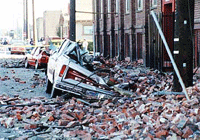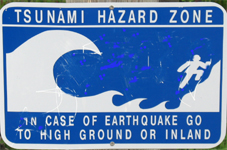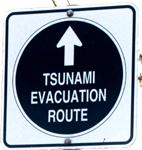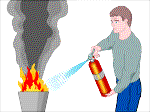I teach an earthquake preparedness class for various Adult and Community Education centers, neighborhood associations and local companies. The presentation can run for a half hour to two or three hours.
A recent FEMA study found that 30 percent of people have not prepared because they think that emergency responders will help them, and over 60 percent say they expect to rely on emergency responders in the first 72 hours following a disaster.
Emergency managers warn us: “YOYO96…You’re on your own for 96 hours. With preparation you can get through it… if you have thought through everything you can be prepared…”
Being prepared to be self-sufficent for 96 hours or longer after a quake will also prepare you for winter storm power outages or rolling blackouts.
This Red Cross photo gives ample evidence of why you should not run outside during a quake:

According to the Red Cross “During the past ten years, earthquakes throughout California have caused 120 deaths and an estimated $50 billion in reported damage. Most Californians live within 20 miles of a major active earthquake fault, but even after seeing the destruction of the Loma Prieta earthquake thirteen years ago, many people aren’t prepared for the next significant shaker.
Since devastating quakes give no warning, how well a family survives an earthquake can often depend on how well they prepare beforehand. With a little planning and effort, the risk of injury and damage can easily be reduced.”
“Nationally, polls show that only about one in every 14 people have taken the necessary measures to prepare for a disaster.
Perceptions are partly to blame — perceptions that disasters can be avoided easily and pose minimal risk to any single person. Another factor is complacency, which has several causes. Some of the complacency toward earthquakes stems from the fact that California is prone to temblors, and over time most residents become indifferent to warnings about them. In addition, many people believe that some level of risk is unavoidable, so they feel less motivated to prepare for unexpected emergencies.”
The U.S.G.S. has estimated that there is a 63 percent probability that one or more quakes with magnitudes of at least 6.7 will strike somewhere in the Bay Area between now and 2038 and a 99.7% probability of such a quake somewhere in California.
“Regardless of where earthquakes occur in the Bay Area, they will produce damaging ground motions over broad areas and substantial distances from the source.”
![]() The class can start with the complete Red Cross course “Living on the Faultline.” The 24 page Red Cross workbook “Living with Earthquakes” is provided free for classes by the Red Cross. It has sections on preparing for an earthquake, what to do during and after the quake as well as a list of essential disaster supplies. Its format follows the video for the course and makes it easy to go home and explain what you learned.
The class can start with the complete Red Cross course “Living on the Faultline.” The 24 page Red Cross workbook “Living with Earthquakes” is provided free for classes by the Red Cross. It has sections on preparing for an earthquake, what to do during and after the quake as well as a list of essential disaster supplies. Its format follows the video for the course and makes it easy to go home and explain what you learned.
With extra time our class goes into detail, with a book to bring home, on how to set up a family disaster plan, covering lists of things you need for your home, in your car and at work. Also a list of important family documents to evacuate with (or store elsewhere in advance and suggestions on how to make a videotape of your home for possible insurance claims. We cover what to do in advance and at the time in case of fire. Special instructions for children, what to do if you are stuck in an elevator and what to do with pets are popular discussions. We cover the details of how to store or purify water.
We can cover how to do a “What if?” survey of your home. You should walk around and imagine a lot of shaking, then decide which of the 30+ projects listed you’ll need to do. Most of them a handyperson can do themselves, but we also cover the eight situations when you should call an engineer, not just a contractor, about your home.
Since this is a lot of work, we also tackle prioritizing what to do first, with a list of the fastest, cheapest, easiest (but still important) things to do first.
The class can also include a brief review of first aid.
– – – – – – – – – – – – – – – – – – – – – – – – – – – – – – – – – – – – – – – – – – – – – – – – – – – – – – – – – –
Some of the main points of the video/workbook are:
Emergency workers may not be able to help you right away, so you need to prepare.
To prepare for an earthquake, the American Red Cross recommends:
Prepare a home earthquake plan
Practice DROP, COVER AND HOLD ON. Drop under a sturdy desk or table, hold on, and protect your eyes by covering your face with your arm. If there’s no table or desk nearby, sit on the floor against an interior wall away from windows, bookcases, or tall furniture that could fall on you
Teach children to DROP, COVER AND HOLD ON
Take a first aid and CPR class.
Eliminate Hazards
Bolt bookcases, china cabinets and other tall furniture to wall studs. Strap the water heater to wall studs. Install strong latches on cupboards
Consult a professional to find additional ways you can protect your home
Prepare a disaster supply kit or purchase one through the Red Cross
Include a first aid kit – First aid kits and disaster kits are available through the Red Cross and at most pharmacies and groceries.
Include essential medicines, canned food, a non-electric can-opener, and at least three gallons of water per person
Keep a battery-powered radio, flashlight (electric torch) and plenty of extra batteries on hand
Know what to do when the shaking starts
DROP, COVER AND HOLD ON
If you are outdoors, find a clear spot away from buildings, trees and power lines
If you are in a car, slow down, drive to a clear place, and stay in the car until the shaking stops
If you are at the beach and feel a quake big enough to make you have trouble standing up, or a strong quake that lasts 20 seconds or more, a tsunami with waves 10 or even 20 feet high is coming within minutes and you must go to higher ground right away. You do not have time to pick up the picnic/towels/ swim gear or move your car. Grab friends/family and start running. Be careful to avoid downed power lines and buildings that might be coming down in aftershocks.


Identify what to do after the shaking stops
Check yourself and others for injuries and give first aid as needed
Look for and extinguish small fires. Inspect your home for damage
Use the telephone only to report life-threatening emergencies
If you can’t get to Cupertino for the class, or you have the time to do the research yourself, start at:
earthquake home hazards survey
A family (and babysitters, caregivers, overnight guests) disaster plan is at:


Earthquake information sources is a page of links to most often needed how-to-do-it information from PG&E, City of San Leandro, Association of Bay Area Governments, Los Angeles Fire Department, USGS, Red Cross, and the Federal Insurance and Mitigation Administration. This page includes a link to detailed maps (with zoom in capability) of potential road closures, risk of liqufaction and flooding (including if a local dam fails during a quake).
Helping Children Cope With Disaster
Store water for after an earthquake
Babysitter Consent and Contact Form
Earthquake and pets advice Consider having the vet ‘microchip’ your pets, and more… Wouldn’t it be easier to transport your cat in a real carrier s/he is used to than in a pillowcase?
Overwhelmed by the amount of things to do to prepare for a disaster?
Try: Fast, easy, cheap earthquake preparedness for the first to do.

Someday you may need an A B C type fire extinguisher in the garage, kitchen and your car.
choosing and using fire extinguishers
https://www.usfa.fema.gov/prevention/outreach/extinguishers.html
Reconsider buying a gas mask for emergencies. According to a Good Housekeeping article:
“They’re a waste of money, experts say. You would have to wear the gas mask constantly to be safe. Gas masks also need to be fitted by an expert and the filter inside might not block all toxic agents.” The article goes on to say “Stockpiling drugs in case of bioterrorism is a guessing game. No antibiotic can protect against all bugs. Use only if a doctor prescribes them.”
Are you one of the people who still has the head of your bed under the window where the glass can break in your face while you sleep? You could make this the first thing you fix – – right now! Most injuries in some early morning earthquakes are from cut feet. Be sure each family member has a pair of shoes right by the bed to put on before they walk around and get their feet cut on broken glass.